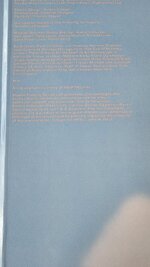dansomeone
Well-Known Member
Oooooooohhhhhhhh, like Wizard of Oz and Dark Side? How was it?In college I once watched Cabin Boy synced with Ween's the Mollusk.
Oooooooohhhhhhhh, like Wizard of Oz and Dark Side? How was it?In college I once watched Cabin Boy synced with Ween's the Mollusk.
Oooooooohhhhhhhh, like Wizard of Oz and Dark Side? How was it?
what is RL?My Rage debut album is RL and it's so good.
Robert Ludwig, mastering engineerwhat is RL?

Digital tape is still tape, no?I kept my backorder for Making Movies and Brothers in Arms to finish out the Mofi Dire Straights collection.
Good lord they actually printed "original master tape" on the Brothers in Arms jacket.
This wasn't even originally recorded to tape
LP sounds good anyway. I've been working for a while to complete this set and might as well finish it.
View attachment 147777
There's no such thing as digital tape.Digital tape is still tape, no?
There's no such thing as digital tape.
They cloned a digital master file.
Although, their use of the word clone is a little odd.

 en.m.wikipedia.org
en.m.wikipedia.org
Digital audio tape is a thing. Known as DAT commonly but that may be a specific format. Apparently Brothers in Arms was one of the first albums to be recorded on a Sony 24-track digital tape machine. Sony PCM-3324.There's no such thing as digital tape.
They cloned a digital master file.
Although, their use of the word clone is a little odd.
 en.wikipedia.org
en.wikipedia.org
Yeah DAT tapes and DVC tapes used to be widely used in media. I used both of them frequently when I got into TV and Radio.Ok I've never heard cassette tape called digital tape before.
Apparently they are different formulations and digital reel tape is not compatible with analog reel tape. I think standard audio cassettes are typically analog but digital ones exist as well.Ok I've never heard cassette tape called digital tape before.
Yeah DAT tapes and DVC tapes used to be widely used in media. I used both of them frequently when I got into TV and Radio.
So you're a movie star?Yeah DAT tapes and DVC tapes used to be widely used in media. I used both of them frequently when I got into TV and Radio.
Close, Technical Director.So you're a movie star?
I worked for a digital tape company for a few years in a previous career, and it's still by far the most economical and environmentally friendly option for server backups, and anything deep archive. It's just slower than SSD options. Despite decades of materials scientists claiming they were on the cusp of better long term storage solutions that don't suffer from data degradation they've never been able to perfect any of the ideas or make them cost effective for wide-spread adaptation. But the coolest I saw at the National Association of Broadcasters tradeshow in Vegas about 15 years ago was a crystal cube that they claimed they would eventually be able to laser etch the data around the area of these microscopic spherical tubes running through the cube. It was supposed to be able to make the data readable for thousands of years, but it had no rewrite capability and estimates at the time were over 100K per cube which then could fit about 5TB, something they've shot way past with Linear Tape Open (LTO).I work in such an advanced place that we only finally got rid of a room full of digital tapes as the server backup just before Covid…
Wow. Didn't know this. I was PIFed the 2012 MOV pressing, and sure enough Bob Ludwig is credited with the mastering. Guess I made out well there.Yeah mine is the first MOV that used the OG plates. It's fantastic. It's one that I pinpointed early on that I really wanted so I searched it out about five years ago and even then it took some work.